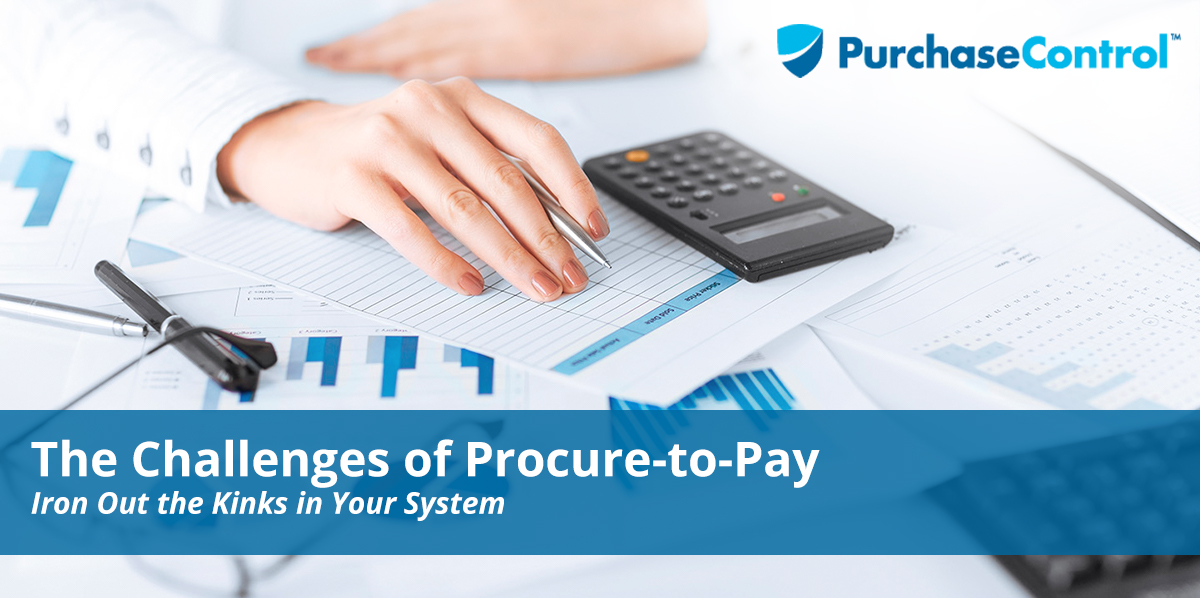The procure-to-pay (P2P) process starts when goods or services are required and ends with payment for said goods and services. The process in many industries is essential to keeping things running smoothly. Procurement efficiency is cortical and is the responsibility of the strategic sourcing and procurement departments. The department must find the right supplier, negotiate contracts, minimize spending, and find ways to automate the purchasing cycle.
Many industries face several challenges in this area but are working to take action to address them.
The Challenges of Procure-to-Pay
Unifying Systems and Processes
Large departments within organizations have their own processes and tools to manage procurement, which makes consolidating data difficult and inconvenient. Sourcing, procurement, and accounts payable are all managed by a different department, and the departments generally optimize the process specifically for their function. Companies often use more than one ERP system that makes it hard to have a single and integrated source of accurate data for supplier and business data. The silos create inefficient processes that are error-prone and manual, such as handling everything on paper invoices, which ends up costing the organization more money in additional labor costs.
Lack of Governance and Compliance
Generally speaking, governance and compliance of procurement processes tend to be inflexible. The key principle of spend preapproval is often viewed as unwanted bureaucracy, which results in non-contracted spend and ad-hoc purchases.
“Policy compliance is critical to keeping maverick spend at bay, which when left unchecked can do some serious damage to your working capital and cash flow.”
Management Apathy
Management often sees procurement processes as non-critical to business operations, which means that upgrading technology and improving processes are often low priority, if on the radar at all. As such, the inefficiencies often sneak up as a result of long-term use of the old way – either because procurement processes aren’t given the appropriate consideration or because they are relying on outdated technology.
Lack of Adoption
Users may find certain procurement systems difficult to use. B2C systems such as Google and Amazon have caused users to expect more from B2B systems. Users expect simple and intuitive experiences in their business environment, many procurement systems don’t meet those expectations. Since procurement software is typically designed by purchasing professionals who are more familiar with complexities, the systems are often full of features and lack the appropriate focus on usability. User training isn’t adequate enough and users aren’t properly advised on procurement policy. This leads to frustrated businesses that are reluctant to adopt P2P technology.
Change Management
Change management is difficult in any organization, especially large ones that are dealing with complex changes across the organization. Users often complain because they aren’t consulted before changes are made and kept in the loop about possible solutions. If you don’t include your staff in the process of choosing the right procurement solution for your company, it may cause situations after you implement the changes because the chosen solution doesn’t meet user needs or solve problems. Requirements change often, which makes it difficult for the technology team to ensure timely delivery and quality results.
How to Address Procure-to-Pay Challenges
Begin with Automation
To reduce operational costs, while also increasing the P2P process efficiency, it’s important to implement procure to pay automation throughout the procure to pay cycle. With electronic purchase requisitions that automatically convert to purchase orders when approved, automated approval routing, and e-invoicing, the process runs much smoother for your organization and your suppliers. Adopting this technology allows the procurement team to focus more of its efforts on high-value activities to add value to the organization while enabling the accounts payable department to be more productive and reduce costs. And perhaps most importantly, it goes a great way in improving supplier relationships throughout the supply chain because it increases timely payment. You’ll no longer have to worry about late payment fees and may even be able to capture early payment discounts, which provides another area of cost savings.
Focus on the User Experience
Investing in technology and processes is necessary for streamlining and reducing costs, but the investments are only worth it when employees use the system the way it is intended. If your team finds the software difficult to you use, they will resort to easier workarounds, resulting in a failed business case. Aim for a procurement solution that provides an intuitive and responsive user experience. As you test various options, it is ideal to conduct a usability assessment with a usability framework such as the system usability scale (SUS). Using a framework like this will give you an objective rating and subjective evaluation so you can identify the areas you need to solve usability issues as you compare your options.
Think About Design
The best organizations have adopted a human-centric approach to designing and developing procurement solutions. Design thinking is an approach that helps develop new solutions where the focus is on the users and usability. As time goes on, this approach is proving to be better because it’s easier for people to use.
Use Cloud Technology
When it comes to company master data, security is understandably the main concern. Because cloud technology has come a long way since the early days, it can benefit business units in a number of ways. It helps to standardize business processes, improve efficiency, and reduce operational costs. It also simplifies change management because support packs and other changes can be applied system-wide quickly and efficiently.
Keep Things Mobile
Traditionally, procurement was only done in-house with a P2P web portal or with electronic forms. Now, however, users are expecting their companies to provide access anytime, anywhere, which means organizations must use or develop solutions that are not device specific. The mobile-first approach keeps the experience simple and allows for an easy buying experience online. Anytime, anywhere access has improved the procurement experience and reduced turnaround time for requests.
Common Pain Points with Purchase to Pay
Non-PO Invoices
Despite having contracted spend and catalog set up in the system, users are still buying goods other ways. This behavior causes issues with handling the non-PO based invoice.
The solution is to enforce a “No PO No Pay” process across vendors, which means the vendors for whom there isn’t a purchase order will not be paid. The change mandates all requestors to create purchase orders for vendors. This reduces maverick spend and reduces costs associated with non-PO processing.
Lack of Global Spend Visibility
Reporting on spend is a cumbersome process when the data must be downloaded from multiple sources and manual processes are used to generate the reports.
The solution is to use a procurement system that has a built-in reporting functionality that can be automated to generate certain reports as often as they are needed. Ideally, the solution will allow for custom report creation, too.
The benefit is that auto-generated reports can be automatically sent to any senior management as required. This reduces the manual effort so people can focus on other important tasks, and there is an increased turnaround time to generate reports.
High Turnaround Time for Approvals
It takes too much time to approve purchasing requests. The delay results in a high turnaround time to process documents.
Using a procurement solution that offers mobile access, either via app or web, enables approvers to log into the system and approve or disprove purchase requests as they come in. This reduces the turnaround time, so requests are approved, and documents are processed faster. In turn, that improves usability and increases adoption of the P2P application.
Turning to a purchase-to-pay system that houses everything in a central location that’s accessible from anywhere there is an internet connection makes it easier on everyone in your organization. The system forces compliance because it doesn’t allow users to exceed their spending limits or use vendors outside of the system. It gives you a clear view of real-time budget information, provides access to vendor contracts, automatically routes orders and invoices for approval, and more.
PurchaseControl offers procurement solutions designed to make your purchasing process as efficient as possible – eliminating the need for paper-based manual processes.
Find Out How








